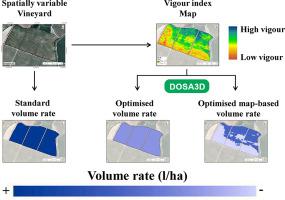当前位置:
X-MOL 学术
›
Biosyst. Eng.
›
论文详情
Our official English website, www.x-mol.net, welcomes your feedback! (Note: you will need to create a separate account there.)
Spatially variable pesticide application in vineyards: Part II, field comparison of uniform and map-based variable dose treatments
Biosystems Engineering ( IF 5.1 ) Pub Date : 2020-07-01 , DOI: 10.1016/j.biosystemseng.2020.04.013 Carla Román , Jordi Llorens , Asier Uribeetxebarria , Ricardo Sanz , Santiago Planas , Jaume Arnó
Biosystems Engineering ( IF 5.1 ) Pub Date : 2020-07-01 , DOI: 10.1016/j.biosystemseng.2020.04.013 Carla Román , Jordi Llorens , Asier Uribeetxebarria , Ricardo Sanz , Santiago Planas , Jaume Arnó

|
Reducing pesticide use is an important concern for many including the European Commission. One way to achieve this goal is to adjust the amount of pesticides in relation to canopy geometry and foliage. This objective currently poses an important challenge in vineyards with uniform vegetation but it is an added difficulty when the canopy shows spatial variability within the field. Is it possible to set a constant volume rate adjusted to this variability? Or is it more convenient to adjusting different volume rates based on a prescription map? Assuming a plant cell density (PCD) vegetation index from multispectral images to be optimal for detecting variations in vigour, two methods to adjust volume rates in spatially variable vineyards were proposed and tested: i) adjustment of a constant volume rate uniformly applied using a conventional sprayer, and ii) adjustment of two volume rates adapted to two vigour classes according to a prescription map. In both methods, PCD was previously correlated to the leaf area index (LAI), then taking the 70th percentile of LAI to determine adjusted volume rates through DOSA3D decision support system ( www.dosa3d.cat/en ). Leaf deposition with tracer was analysed to compare the proposed methods with the standard volume rate commonly used in the area. Statistical analysis showed no significant differences between treatments. Since pesticide savings can be achieved using the two methods, specifically 25.6% in adjusted uniform and 25.3% in adjusted map-based treatments, adjusted volume rate strategies can be recommended in vineyards with spatial variability.
中文翻译:

葡萄园中空间可变农药的施用:第二部分,统一和基于地图的可变剂量处理的田间比较
减少农药的使用是包括欧盟委员会在内的许多人关注的一个重要问题。实现这一目标的一种方法是根据树冠几何形状和树叶来调整杀虫剂的用量。目前,该目标对植被均匀的葡萄园构成了重要挑战,但当树冠在田地内显示出空间变异性时,这是一个额外的困难。是否可以设置一个恒定的体积速率来适应这种变化?还是根据处方图调整不同的容积率更方便?假设来自多光谱图像的植物细胞密度 (PCD) 植被指数对于检测活力变化是最佳的,提出并测试了两种调整空间可变葡萄园体积率的方法:i) 使用常规方法统一应用的恒定体积率的调整喷雾器,ii) 根据处方图调整适应两个活力等级的两个容积率。在这两种方法中,PCD 之前都与叶面积指数 (LAI) 相关联,然后通过 DOSA3D 决策支持系统 (www.dosa3d.cat/en) 取 LAI 的第 70 个百分位数来确定调整后的体积率。分析了带示踪剂的叶片沉积,以将所提出的方法与该地区常用的标准体积率进行比较。统计分析显示治疗之间没有显着差异。由于使用这两种方法可以节省农药,特别是在调整后的均匀处理中节省 25.6%,在调整后的基于地图的处理中节省 25.3%,因此可以在具有空间变异性的葡萄园中推荐调整容积率策略。在这两种方法中,PCD 之前都与叶面积指数 (LAI) 相关联,然后通过 DOSA3D 决策支持系统 (www.dosa3d.cat/en) 取 LAI 的第 70 个百分位数来确定调整后的体积率。分析了带示踪剂的叶片沉积,以将所提出的方法与该地区常用的标准体积率进行比较。统计分析显示治疗之间没有显着差异。由于使用这两种方法可以节省农药,特别是在调整后的均匀处理中节省 25.6%,在调整后的基于地图的处理中节省 25.3%,因此可以在具有空间变异性的葡萄园中推荐调整容积率策略。在这两种方法中,PCD 之前都与叶面积指数 (LAI) 相关联,然后通过 DOSA3D 决策支持系统 (www.dosa3d.cat/en) 取 LAI 的第 70 个百分位数来确定调整后的体积率。分析了带示踪剂的叶片沉积,以将所提出的方法与该地区常用的标准体积率进行比较。统计分析显示治疗之间没有显着差异。由于使用这两种方法可以节省农药,特别是在调整后的均匀处理中节省 25.6%,在调整后的基于地图的处理中节省 25.3%,因此可以在具有空间变异性的葡萄园中推荐调整容积率策略。猫/英文)。分析了带示踪剂的叶片沉积,以将所提出的方法与该地区常用的标准体积率进行比较。统计分析显示治疗之间没有显着差异。由于使用这两种方法可以节省农药,特别是在调整后的均匀处理中节省 25.6%,在调整后的基于地图的处理中节省 25.3%,因此可以在具有空间变异性的葡萄园中推荐调整容积率策略。猫/英文)。分析了带示踪剂的叶片沉积,以将所提出的方法与该地区常用的标准体积率进行比较。统计分析显示治疗之间没有显着差异。由于使用这两种方法可以节省农药,特别是在调整后的均匀处理中节省 25.6%,在调整后的基于地图的处理中节省 25.3%,因此可以在具有空间变异性的葡萄园中推荐调整容积率策略。
更新日期:2020-07-01
中文翻译:

葡萄园中空间可变农药的施用:第二部分,统一和基于地图的可变剂量处理的田间比较
减少农药的使用是包括欧盟委员会在内的许多人关注的一个重要问题。实现这一目标的一种方法是根据树冠几何形状和树叶来调整杀虫剂的用量。目前,该目标对植被均匀的葡萄园构成了重要挑战,但当树冠在田地内显示出空间变异性时,这是一个额外的困难。是否可以设置一个恒定的体积速率来适应这种变化?还是根据处方图调整不同的容积率更方便?假设来自多光谱图像的植物细胞密度 (PCD) 植被指数对于检测活力变化是最佳的,提出并测试了两种调整空间可变葡萄园体积率的方法:i) 使用常规方法统一应用的恒定体积率的调整喷雾器,ii) 根据处方图调整适应两个活力等级的两个容积率。在这两种方法中,PCD 之前都与叶面积指数 (LAI) 相关联,然后通过 DOSA3D 决策支持系统 (www.dosa3d.cat/en) 取 LAI 的第 70 个百分位数来确定调整后的体积率。分析了带示踪剂的叶片沉积,以将所提出的方法与该地区常用的标准体积率进行比较。统计分析显示治疗之间没有显着差异。由于使用这两种方法可以节省农药,特别是在调整后的均匀处理中节省 25.6%,在调整后的基于地图的处理中节省 25.3%,因此可以在具有空间变异性的葡萄园中推荐调整容积率策略。在这两种方法中,PCD 之前都与叶面积指数 (LAI) 相关联,然后通过 DOSA3D 决策支持系统 (www.dosa3d.cat/en) 取 LAI 的第 70 个百分位数来确定调整后的体积率。分析了带示踪剂的叶片沉积,以将所提出的方法与该地区常用的标准体积率进行比较。统计分析显示治疗之间没有显着差异。由于使用这两种方法可以节省农药,特别是在调整后的均匀处理中节省 25.6%,在调整后的基于地图的处理中节省 25.3%,因此可以在具有空间变异性的葡萄园中推荐调整容积率策略。在这两种方法中,PCD 之前都与叶面积指数 (LAI) 相关联,然后通过 DOSA3D 决策支持系统 (www.dosa3d.cat/en) 取 LAI 的第 70 个百分位数来确定调整后的体积率。分析了带示踪剂的叶片沉积,以将所提出的方法与该地区常用的标准体积率进行比较。统计分析显示治疗之间没有显着差异。由于使用这两种方法可以节省农药,特别是在调整后的均匀处理中节省 25.6%,在调整后的基于地图的处理中节省 25.3%,因此可以在具有空间变异性的葡萄园中推荐调整容积率策略。猫/英文)。分析了带示踪剂的叶片沉积,以将所提出的方法与该地区常用的标准体积率进行比较。统计分析显示治疗之间没有显着差异。由于使用这两种方法可以节省农药,特别是在调整后的均匀处理中节省 25.6%,在调整后的基于地图的处理中节省 25.3%,因此可以在具有空间变异性的葡萄园中推荐调整容积率策略。猫/英文)。分析了带示踪剂的叶片沉积,以将所提出的方法与该地区常用的标准体积率进行比较。统计分析显示治疗之间没有显着差异。由于使用这两种方法可以节省农药,特别是在调整后的均匀处理中节省 25.6%,在调整后的基于地图的处理中节省 25.3%,因此可以在具有空间变异性的葡萄园中推荐调整容积率策略。


























 京公网安备 11010802027423号
京公网安备 11010802027423号